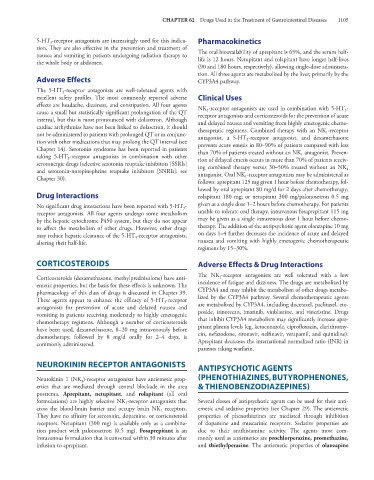Page 1119 - Basic _ Clinical Pharmacology ( PDFDrive )
P. 1119
CHAPTER 62 Drugs Used in the Treatment of Gastrointestinal Diseases 1105
5-HT -receptor antagonists are increasingly used for this indica- Pharmacokinetics
3
tion. They are also effective in the prevention and treatment of
nausea and vomiting in patients undergoing radiation therapy to The oral bioavailability of aprepitant is 65%, and the serum half-
the whole body or abdomen. life is 12 hours. Netupitant and rolapitant have longer half-lives
(90 and 180 hours, respectively), allowing single-dose administra-
tion. All three agents are metabolized by the liver, primarily by the
Adverse Effects CYP3A4 pathway.
The 5-HT -receptor antagonists are well-tolerated agents with
3
excellent safety profiles. The most commonly reported adverse Clinical Uses
effects are headache, dizziness, and constipation. All four agents NK -receptor antagonists are used in combination with 5-HT -
3
1
cause a small but statistically significant prolongation of the QT receptor antagonists and corticosteroids for the prevention of acute
interval, but this is most pronounced with dolasetron. Although and delayed nausea and vomiting from highly emetogenic chemo-
cardiac arrhythmias have not been linked to dolasetron, it should therapeutic regimens. Combined therapy with an NK -receptor
1
not be administered to patients with prolonged QT or in conjunc- antagonist, a 5-HT -receptor antagonist, and dexamethasone
3
tion with other medications that may prolong the QT interval (see prevents acute emesis in 80–90% of patients compared with less
Chapter 14). Serotonin syndrome has been reported in patients than 70% of patients treated without an NK antagonist. Preven-
1
taking 5-HT -receptor antagonists in combination with other tion of delayed emesis occurs in more than 70% of patients receiv-
3
serotonergic drugs (selective serotonin reuptake inhibitors [SSRIs] ing combined therapy versus 30–50% treated without an NK
1
and serotonin-norepinephrine reuptake inhibitors [SNRIs]; see antagonist. Oral NK -receptor antagonists may be administered as
Chapter 30). 1
follows: aprepitant 125 mg given 1 hour before chemotherapy, fol-
lowed by oral aprepitant 80 mg/d for 2 days after chemotherapy;
Drug Interactions rolapitant 180 mg; or netupitant 300 mg/palonosetron 0.5 mg
No significant drug interactions have been reported with 5-HT - given as a single dose 1–2 hours before chemotherapy. For patients
3
receptor antagonists. All four agents undergo some metabolism unable to tolerate oral therapy, intravenous fosaprepitant 115 mg
by the hepatic cytochrome P450 system, but they do not appear may be given as a single intravenous dose 1 hour before chemo-
to affect the metabolism of other drugs. However, other drugs therapy. The addition of the antipsychotic agent olanzapine 10 mg
may reduce hepatic clearance of the 5-HT -receptor antagonists, on days 1–4 further decreases the incidence of acute and delayed
3
altering their half-life. nausea and vomiting with highly emetogenic chemotherapeutic
regimens by 15–30%.
CORTICOSTEROIDS Adverse Effects & Drug Interactions
Corticosteroids (dexamethasone, methylprednisolone) have anti- The NK -receptor antagonists are well tolerated with a low
1
emetic properties, but the basis for these effects is unknown. The incidence of fatigue and dizziness. The drugs are metabolized by
pharmacology of this class of drugs is discussed in Chapter 39. CYP3A4 and may inhibit the metabolism of other drugs metabo-
These agents appear to enhance the efficacy of 5-HT -receptor lized by the CYP3A4 pathway. Several chemotherapeutic agents
3
antagonists for prevention of acute and delayed nausea and are metabolized by CYP3A4, including docetaxel, paclitaxel, eto-
vomiting in patients receiving moderately to highly emetogenic poside, irinotecan, imatinib, vinblastine, and vincristine. Drugs
chemotherapy regimens. Although a number of corticosteroids that inhibit CYP3A4 metabolism may significantly increase apre-
have been used, dexamethasone, 8–20 mg intravenously before pitant plasma levels (eg, ketoconazole, ciprofloxacin, clarithromy-
chemotherapy, followed by 8 mg/d orally for 2–4 days, is cin, nefazodone, ritonavir, nelfinavir, verapamil, and quinidine).
commonly administered. Aprepitant decreases the international normalized ratio (INR) in
patients taking warfarin.
NEUROKININ RECEPTOR ANTAGONISTS ANTIPSYCHOTIC AGENTS
Neurokinin 1 (NK )-receptor antagonists have antiemetic prop- (PHENOTHIAZINES, BUTYROPHENONES,
1
erties that are mediated through central blockade in the area & THIENOBENZODIAZEPINES)
postrema. Aprepitant, netupitant, and rolapitant (all oral
formulations) are highly selective NK -receptor antagonists that Several classes of antipsychotic agents can be used for their anti-
1
cross the blood-brain barrier and occupy brain NK receptors. emetic and sedative properties (see Chapter 29). The antiemetic
1
They have no affinity for serotonin, dopamine, or corticosteroid properties of phenothiazines are mediated through inhibition
receptors. Netupitant (300 mg) is available only as a combina- of dopamine and muscarinic receptors. Sedative properties are
tion product with palonosetron (0.5 mg). Fosaprepitant is an due to their antihistamine activity. The agents most com-
intravenous formulation that is converted within 30 minutes after monly used as antiemetics are prochlorperazine, promethazine,
infusion to aprepitant. and thiethylperazine. The antiemetic properties of olanzapine

